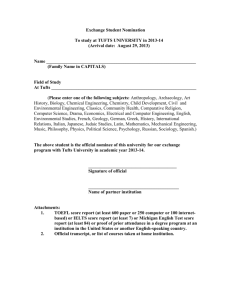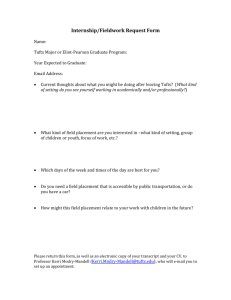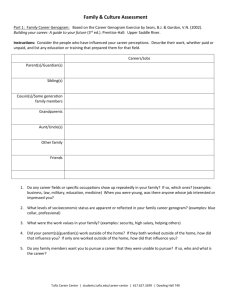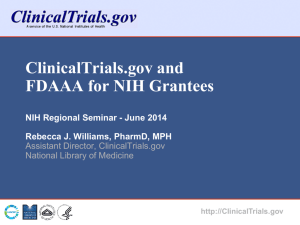Statistical Needs for Pragmatic Clinical Trials
advertisement
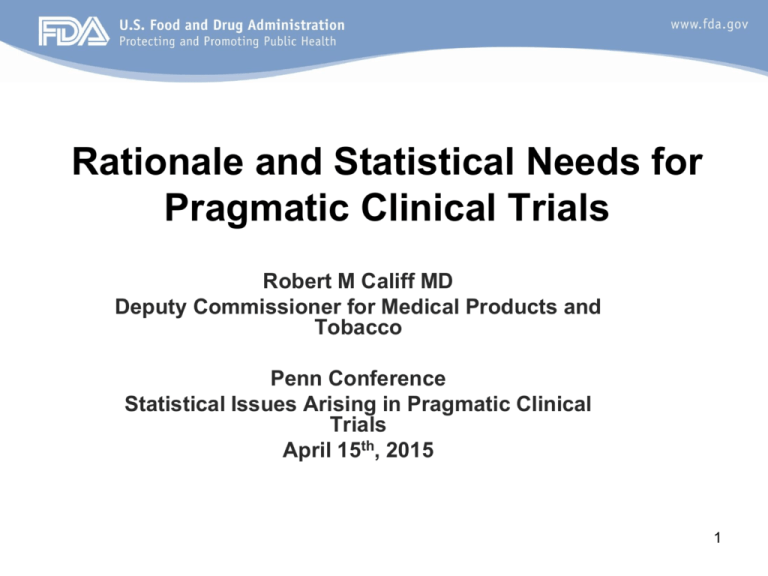
Rationale and Statistical Needs for Pragmatic Clinical Trials Robert M Califf MD Deputy Commissioner for Medical Products and Tobacco Penn Conference Statistical Issues Arising in Pragmatic Clinical Trials April 15th, 2015 1 Statistical Needs in PCTs • Why is pragmatism so important now? • What is a pragmatic clinical trial? • PCTs are a team sport • Role of the statistician 2 Premise • Choices about health and health care are best made when patients, clinicians and policy makers have access to convincing scientific evidence to inform and guide their decisions • Unfortunately, healthcare decisions too often based on subjective impressions or indirect comparisons from studies not designed to inform decision-making with high quality level of evidence 3 Premise • Field of clinical research is maturing and tools have grown increasingly sophisticated • Frailty of existing body of medical knowledge used to support practice has been revealed • Solution: data-rich integration of research and practice 4 Deaths per 100,000 Mortality in the 20th Century 3000 Better treatment of cardiovascular disease, low birth-weight infants 2000 1000 Reduced infectious disease mortality (clean water, sewers, antibiotics, better nutrition) 0 1900 1910 1920 1930 1940 1950 1960 1970 1980 1990 82 Life Expectancy (years) White females 78 Black females White males 74 70 Black males 66 62 1975 Adapted from Harper et al, JAMA 2007;297:1224–1232 1985 1995 Year Life Expectancy at Birth 2005 % In-hospital Mortality Link Between Overall ACC/AHA Guidelines Adherence and Mortality 8 Adjusted Unadjusted 6 4 2 0 Every 10% in guidelines adherence 11% in mortality ≤25 25–50% 50–75% ≥75 Hospital Composite Quality Quartiles Peterson et al, ACC 2004 Which Treatment is Best for Whom? High-Quality Evidence is Scarce < 15% of guideline recommendations supported by high quality evidence 8 Tricoci P et al. JAMA 2009;301:831-41 Tufts study accounts for direct costs, failures, and investors’ opportunity cost The Tufts $2.6B figure for the average cost of bringing an NME to market has three components: a) Direct cash costs of developing the NME b) Cash expenditures on failed drugs Currently Available Cost Decomposition in Tufts (2014) Cash costs 1600 $M 1400 1200 1000 800 c) Cost of capital 600 (i.e. expected rate of return) 400 200 Note: Not all Tufts 2014 study parameters have been released Economics Staff Office of Program and Strategic Analysis (OPSA) 0 Pre-clinical Clinical Cost of capital Direct costs + Cost of failures Source: Tufts 2014 •9 Studies of in-house drug R&D spending do not exactly agree on trends Basic cost decomposition across studies of in-house R&D Studies are consistent on rising clinical costs but inconsistent on spending on in-house preclinical development 1,200 1,000 800 Tufts 2003 600 Paul 2010 M-F 2012 400 Tufts 2014 200 In-house R&D development duration 0 Cash pre-clinical Tufts 2014 M-F 2012 Paul 2010 Tufts 2003 0 50 100 150 200 Months Preclinical CDER Economics Staff Phase 1 Phase 2 Phase 3 NDA Cash clinical Studies seem to suggest that length of Phases 2 and 3 is stable but duration of preclinical phase for in-house R&D may be falling Office of Program and Strategic Analysis (OPSA) •10 Summary • Enormous gap between evidence and need for evidence • New technology development costs are skyrocketing • Therefore a new path is needed CDER Economics Staff Office of Program and Strategic Analysis (OPSA) •11 General Classification • Mechanistic trials – Intent to evaluate a biological or mechanistic hypothesis • Pragmatic trials – Intent to inform decision makers about health and healthcare 12 Elements of PCTs • Compare clinically relevant alternatives • Enroll diverse study population • Recruit from a variety of practice settings • Measure a broad range of relevant health outcomes » Tunis, Stryer and Clancy JAMA 13 Practical Adaptation of PCT Definition (1) an intent to inform decision-makers (patients, clinicians, administrators, and policymakers), as opposed to elucidating a biological or social mechanism; (2) an intent to enroll a population relevant to the decision in practice and representative of the patients/populations and clinical settings for whom the decision is relevant; and (3) either an intent to – (a) streamline procedures and data collection so that the trial can focus on adequate power for informing the clinical and policy decisions targeted by the trial 14 – (b) measure a broad range of outcomes Pragmatic Clinical Trial Fit for the purpose of informing decisionmakers regarding the comparative balance of benefit and risk of a biomedical or behavioral health intervention at the individual or population level We should be striving for pragmatism in every clinical trial 15 Learning health care systems Increasing Level of Difficulty Re-engineering the Clinical Research Enterprise Plan and start a few demonstration networks Simplify complex regulatory systems – demonstration projects Plan for networks in place for all institutes Funding mechanism to sustain national system through consensus of all constituents (“1% solution”) Simplified regulatory system in place for networks National Clinical Research System creates effectiveness data that moves rapidly into the community AND data on outcomes and quality of care; sustained efficient infrastructure to rapidly initiate large clinical trials; scientific information for patients, families, advocacy groups Establish repositories of biological specimens and standards for collection Standardize nomenclature, data standards, core data, forms for most major diseases Start a library of these elements shared between institutes and NLM Develop efficient network administration infrastructure at NIH Develop standards for capturing images for research Data standards shared across NIH institutes ONE medical nomenclature with national data standards (agreed to by NIH, CMS, FDA, DOD, CDC) Data standards updated ‘in real time” through networks National repository of images and samples Critical national “problem list” Most efficient network funding mechanisms in place across NIH Create NIH standards to provide “safe haven” for clinical research Inventory and evaluate existing publicprivate partnerships, networks, CR institutions, and regulatory systems Establish FORUM(S) of all stakeholders Establish standards for and pilot creation of a National Clinical Research Corps Demonstration/planning grants to enhance/evaluate/develop model networks NIH standards for safe haven in place Regulations and ethics harmonized with FDA, CMS Public private partnership mechanisms in place 100,000 members of certified “Clinical Research Corps” Standards shared across NIH 1-3 years Funding mechanisms evaluated to determine which are most efficient 4-7 years Time Participation in research is a professional standard (taught in all health professions schools) Study, evaluation and training regarding clinical research a part of every medical school, nursing school, pharmacy school Clinical research practices documented and updated regularly to maintain safe haven Networks provide detailed training about network specific issues 8-10 years Conclusion Clinical trials registered in ClinicalTrials.gov are dominated by small trials and contain significant heterogeneity in methodological approaches, including reported use of randomization, blinding, and DMCs. •18 18 What Have We Learned? • More trials than previously imagined (>380/week) • Unexplained heterogeneity in – Trial design – Trial oversight • Lack of fidelity to trial protocol is common • Apparent lack of expertise among trial personnel • Published literature does not reflect the “CRE” – Only about 67% of trials ever published – Only some outcome measures published • Discrepancies among various sources of summary data raise questions about validity •19 Prioritization • When deciding upon the question there are several approaches – – – – Traditional peer review (open market place of ideas) Net present value calculations (value to a business) Value of information analysis (value to society) Programmatic decisions based on gaps and needs (“top down”) • Like other decisions priorities should be informed by evidence – Where are the gaps? – What could be gained by a trial? 20 The Team • • • • • Clinical investigators Statisticians Informaticians Operational experts/Regulatory scientists PATIENTS AND PATIENT REPRESENTATIVES • PAYORS/HEALTH SYSTEMS 21 NY Times Dec 25th, 2014 Headline: M.B.A. Programs Start to Follow Silicon Valley Into the Data Age “Meanwhile, across the country, colleges are adding new courses in statistics, data science and A/B testing, which often involves testing different web page designs to see which attracts more traffic.” Even Dilbert is using AB Testing (Randomization) Protocol Design • Traditional statistician roles – Keeping the team focused on hypothesis testing – Calculations for samples size, power, subgroup analysis,etc. • Enhanced roles – Helping to assess data sources – Choosing basic design (CRT, traditional RCT, adaptive, etc.) – Dealing with magnified issues of missing data or uncertainty about key outcomes – Quality by design plan • Statistical process control 24 A well designed pragmatic trial 25 Our usual Clinical Trial after Regulatory/FDA/Academic Interactions 26 One person’s data can be in different places Data in claims Data in ambulatory EHRs Care public health clinic Prescription fills paid out of pocket Data in inpatient EHRs Study Start Up • • • • Efficiency of procedures Practicality of procedures/missingness Assessment of data quality early on Statistical process control procedures 28 http://www.nytimes.com/2014/08/18/technology/for-bigdata-scientists-hurdle-to-insights-is-janitor-work.html?_r=2 Implementation—Trial Monitoring • Interim analysis • Quality by design – Focusing on errors that matter • For CRTs think about Intraclass Correlation Coefficient • Adaptation to observations 30 Analysis • More people at the table • Complex steering committees • Patients and patient advocates 32 “What a couple of clucks we are. Here’s another error up here!” Page 33 Dissemination • • • • • • • ClinicalTrials.gov Placing the result in context Traditional manuscripts Clinical practice guidelines Payers Patient advocacy Transparency 34 Special Article Compliance with Results Reporting at ClinicalTrials.gov Monique L. Anderson, M.D., Karen Chiswell, Ph.D., Eric D. Peterson, M.D., M.P.H., Asba Tasneem, Ph.D., James Topping, M.S., and Robert M. Califf, M.D. N Engl J Med Volume 372(11):1031-1039 March 12, 2015 Cumulative Percentage of Clinical Trials That Reported Results to ClinicalTrials.gov, According to the Time after the Primary Completion Date. Anderson ML et al. N Engl J Med 2015;372:1031-1039 An Aspiration of the Clinical Research System– a reliable product • consistently good in quality or performance; able to be trusted. • "a reliable source of information" • Synonyms: dependable, good, well founded, authentic, valid, genuine, sound , true • The biostatistician is in the best position to be the product manager and assessor • As data get more complicated confidence in the reliability of the product is increasingly dependent on: – Replication – A track record of reliability The Pipeline—Sheer Numbers • There is an absolute shortage of qualified statisticians who can produce reliable results • We need new methods • PhD programs seem more focused on the historical profession than filling the huge societal need • MS programs not linked enough with the clinical research community • We need a national program to increase the supply of quantitatively competent people Pipeline-Integration • Quantitative Sciences – – – – – Biostatistics Statistics Computer science Bioinformatics Data analytics • Clinical Research – People educated in both clinical science and quantitative science – What quantitative skills should be expected of • Clinical investigators • Practitioners

